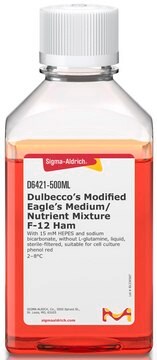D6546
DMEM - high glucose
With sodium Bicarbonate, sodium pyruvate, without ʟ-glutamine, liquid, sterile-filtered, suitable for cell culture
Synonym(s):
DME, Dulbecco′s Modified Eagle′s Medium - high glucose, DMEM
About This Item
Recommended Products
Product Name
Dulbecco′s Modified Eagle′s Medium - high glucose, With 4500 mg/L glucose, sodium pyruvate, and sodium bicarbonate, without L-glutamine, liquid, sterile-filtered, suitable for cell culture
Quality Level
sterility
sterile-filtered
form
liquid
technique(s)
cell culture | mammalian: suitable
impurities
endotoxin, tested
components
NaHCO3: yes
phenol red: yes
sodium pyruvate: yes
HEPES: no
L-glutamine: no
glucose: high
shipped in
ambient
storage temp.
2-8°C
Looking for similar products? Visit Product Comparison Guide
General description
Application
Reconstitution
Related product
also commonly purchased with this product
recommended
supplement
signalword
Warning
hcodes
Hazard Classifications
Skin Sens. 1
Storage Class
12 - Non Combustible Liquids
wgk_germany
WGK 3
flash_point_f
Not applicable
flash_point_c
Not applicable
Choose from one of the most recent versions:
Already Own This Product?
Find documentation for the products that you have recently purchased in the Document Library.
Customers Also Viewed
Articles
Cell culture protocol for passaging and splitting suspension cell lines
Our team of scientists has experience in all areas of research including Life Science, Material Science, Chemical Synthesis, Chromatography, Analytical and many others.
Contact Technical Service






